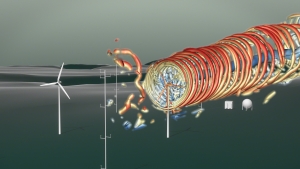Wind energy is to have a major share in the future renewable energy mix. The Germany-wide TremAc project is aimed at improving the planning, development, and acceptance of wind power plants and at developing objective criteria for their emissions. For this purpose, experts will study the interaction of acoustic and seismic vibrations of wind power plants and plan to generate a model to compute both emissions. TremAc is funded with EUR 1.85 million by the Federal Ministry for Economic Affairs and Energy.
“We want to compute the complete chain of effects from the plant to the population,” Theodoros Triantafyllidis, coordinator of the TremAc cooperation project and Head of the Institute of Soil Mechanics and Rock Mechanics of KIT, explains. Within the framework of the TremAc cooperation project, a single chain is to be developed for modeling all vibrating plant components and the surroundings, i.e. the rotating rotor blades, drive shaft, gondola suspension and tower structure, foundation, and the ground, various topographic terrains and airflows as well as adjacent residential buildings and workplaces.
The scientists plan to measure the vibrations propagating in the atmosphere as acoustic and in the ground as seismic waves both for a single wind turbine and in a wind park and to validate the computation models with these data. In parallel, the neighboring population will be interviewed using environmental medicine and psychological questionnaires. The people’s subjective complaints will be related to objective measurements in buildings.
So far, the emission and perception of noise and vibrations has been studied separately in most cases. “This is far too limited in scope to understand why neighbors complain of inconveniences caused by wind power plants even though the required limit values are observed and people should not hear anything physiologically,” Triantafyllidis says. For this reason, the TremAc project will concentrate on studying interactions between airborne sound and structure-borne sound.
The coupled computation models to be developed under the project will help better prognosticate emissions of planned wind power plants and realistically define and continuously review limit values as a function of the plant output, the distance to residential buildings, and topography. In addition, the engineers want to analyze the interactions of individual plant components and the causes of emissions as well as to develop technical solutions for minimizing structure-borne and airborne sound. Finally, assessment criteria are to be objectified by the cooperation of engineers and social scientists.
The TremAc (Objective Criteria for Vibration and Noise Emissions of Inland Wind Power Plants) cooperation project was initiated by the South-German WindForS research cluster. It is funded by the Federal Ministry for Economic Affairs and Energy with about EUR 1.85 million from 2016 to 2019. The partners are Karlsruhe Institute of Technology, the University of Stuttgart, Technische Universität München, the University of Bielefeld, the University of Halle-Wittenberg, and the company Mesh Engineering, Stuttgart. Manufacturers and operators of wind power plants are to join the cooperation.
More about the TremAc project: http://www.windfors.de/english/index.html
The project partners in detail:
Institute of Soil Mechanics and Rock Mechanics (IBF), Geophysical Institute (GPI), Research Center for Steel, Timber, and Masonry (VAKA) of Karlsruhe Institute of Technology (KIT), Stuttgart Wind Energy (SWE) and Institute of Aerodynamics and Gas Dynamics (IAG) of the University of Stuttgart, Wind Energy Institute of Technische Universität München (TUM), Faculty of Health Science of Bielefeld University, Environmental Psychology Working Group of the Institute for Psychology of the Martin Luther University Halle-Wittenberg, Mesh Engineering company, Stuttgart.
In close partnership with society, KIT develops solutions for urgent challenges – from climate change, energy transition and sustainable use of natural resources to artificial intelligence, sovereignty and an aging population. As The University in the Helmholtz Association, KIT unites scientific excellence from insight to application-driven research under one roof – and is thus in a unique position to drive this transformation. As a University of Excellence, KIT offers its more than 10,000 employees and 22,800 students outstanding opportunities to shape a sustainable and resilient future. KIT – Science for Impact.

